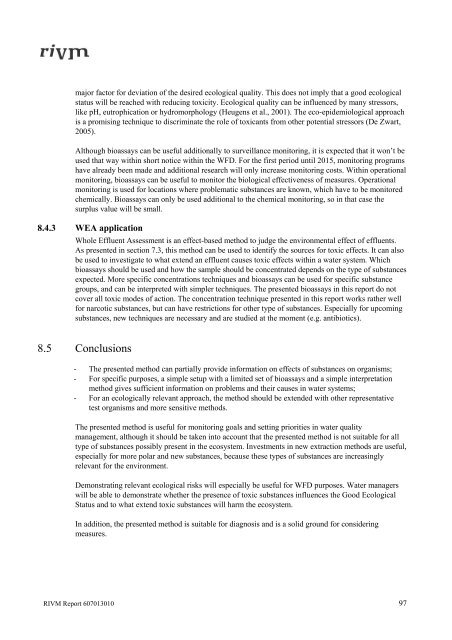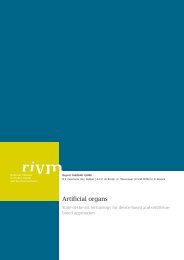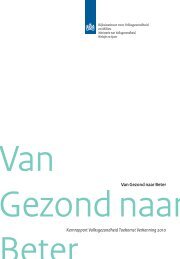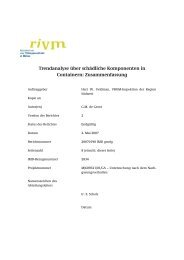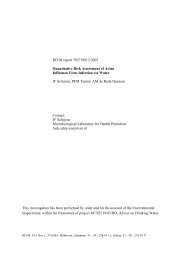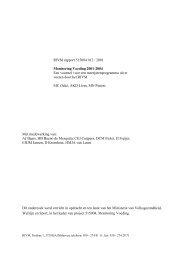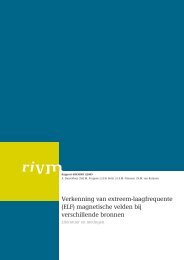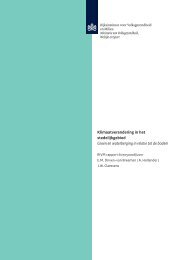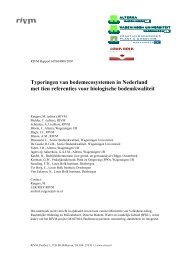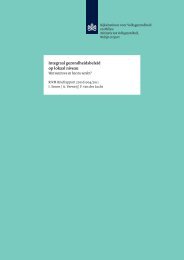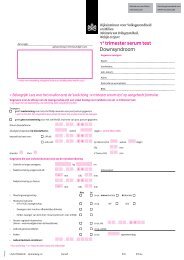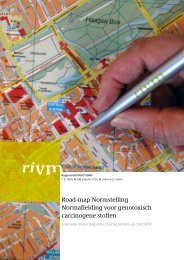Toxicity measurements in concentrated water samples - Rivm
Toxicity measurements in concentrated water samples - Rivm
Toxicity measurements in concentrated water samples - Rivm
Create successful ePaper yourself
Turn your PDF publications into a flip-book with our unique Google optimized e-Paper software.
major factor for deviation of the desired ecological quality. This does not imply that a good ecological<br />
status will be reached with reduc<strong>in</strong>g toxicity. Ecological quality can be <strong>in</strong>fluenced by many stressors,<br />
like pH, eutrophication or hydromorphology (Heugens et al., 2001). The eco-epidemiological approach<br />
is a promis<strong>in</strong>g technique to discrim<strong>in</strong>ate the role of toxicants from other potential stressors (De Zwart,<br />
2005).<br />
Although bioassays can be useful additionally to surveillance monitor<strong>in</strong>g, it is expected that it won’t be<br />
used that way with<strong>in</strong> short notice with<strong>in</strong> the WFD. For the first period until 2015, monitor<strong>in</strong>g programs<br />
have already been made and additional research will only <strong>in</strong>crease monitor<strong>in</strong>g costs. With<strong>in</strong> operational<br />
monitor<strong>in</strong>g, bioassays can be useful to monitor the biological effectiveness of measures. Operational<br />
monitor<strong>in</strong>g is used for locations where problematic substances are known, which have to be monitored<br />
chemically. Bioassays can only be used additional to the chemical monitor<strong>in</strong>g, so <strong>in</strong> that case the<br />
surplus value will be small.<br />
8.4.3 WEA application<br />
Whole Effluent Assessment is an effect-based method to judge the environmental effect of effluents.<br />
As presented <strong>in</strong> section 7.3, this method can be used to identify the sources for toxic effects. It can also<br />
be used to <strong>in</strong>vestigate to what extend an effluent causes toxic effects with<strong>in</strong> a <strong>water</strong> system. Which<br />
bioassays should be used and how the sample should be <strong>concentrated</strong> depends on the type of substances<br />
expected. More specific concentrations techniques and bioassays can be used for specific substance<br />
groups, and can be <strong>in</strong>terpreted with simpler techniques. The presented bioassays <strong>in</strong> this report do not<br />
cover all toxic modes of action. The concentration technique presented <strong>in</strong> this report works rather well<br />
for narcotic substances, but can have restrictions for other type of substances. Especially for upcom<strong>in</strong>g<br />
substances, new techniques are necessary and are studied at the moment (e.g. antibiotics).<br />
8.5 Conclusions<br />
- The presented method can partially provide <strong>in</strong>formation on effects of substances on organisms;<br />
- For specific purposes, a simple setup with a limited set of bioassays and a simple <strong>in</strong>terpretation<br />
method gives sufficient <strong>in</strong>formation on problems and their causes <strong>in</strong> <strong>water</strong> systems;<br />
- For an ecologically relevant approach, the method should be extended with other representative<br />
test organisms and more sensitive methods.<br />
The presented method is useful for monitor<strong>in</strong>g goals and sett<strong>in</strong>g priorities <strong>in</strong> <strong>water</strong> quality<br />
management, although it should be taken <strong>in</strong>to account that the presented method is not suitable for all<br />
type of substances possibly present <strong>in</strong> the ecosystem. Investments <strong>in</strong> new extraction methods are useful,<br />
especially for more polar and new substances, because these types of substances are <strong>in</strong>creas<strong>in</strong>gly<br />
relevant for the environment.<br />
Demonstrat<strong>in</strong>g relevant ecological risks will especially be useful for WFD purposes. Water managers<br />
will be able to demonstrate whether the presence of toxic substances <strong>in</strong>fluences the Good Ecological<br />
Status and to what extend toxic substances will harm the ecosystem.<br />
In addition, the presented method is suitable for diagnosis and is a solid ground for consider<strong>in</strong>g<br />
measures.<br />
RIVM Report 607013010 97


